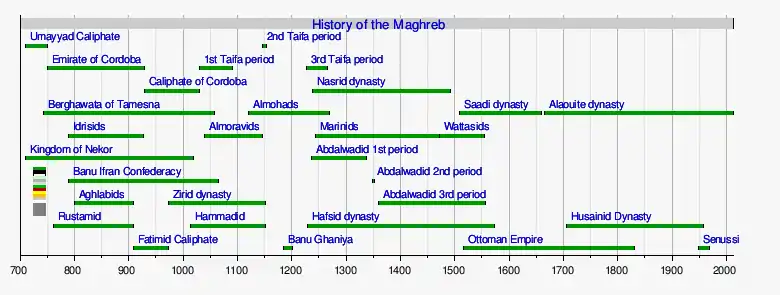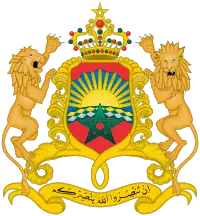Marinid Sultanate
The Marinid Sultanate was an empire from the mid-13th to the 15th century which controlled present-day Morocco and, intermittently, other parts of North Africa (Algeria and Tunisia) and of southern Spain around Gibraltar. It was named after the Banu Marin (Arabic: بنو مرين), a Zenata Berber tribe.[1][3] The sultanate was ruled by the Marinid dynasty (Arabic: المرينيون al-marīniyyūn), or Banu Abd al-Haqq, a family which led the tribe to power.[1][4]
Marinid Sultanate المرينيون al-marīniyyūn (ar) | |||||||||
|---|---|---|---|---|---|---|---|---|---|
| 1244–1465 | |||||||||
 Emblem
| |||||||||
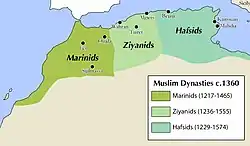 The Marinid Sultanate in 1360 | |||||||||
| Status | Ruling dynasty of Morocco[1][2] | ||||||||
| Capital | Fes | ||||||||
| Common languages | Arabic, Berber | ||||||||
| Religion | Sunni Islam | ||||||||
| Government | Sultanate | ||||||||
| Sultan | |||||||||
• 1215–1217 | Abd al-Haqq I | ||||||||
• 1420–1465 | Abd al-Haqq II | ||||||||
| History | |||||||||
• Established | 1244 | ||||||||
• Disestablished | 1465 | ||||||||
| Currency | Dinar | ||||||||
| |||||||||
| Banu Abd al-Haqq | |
|---|---|
 | |
| Parent house | Banu Marin |
| Country | |
| Founded | 1215 |
| Founder | Abd al-Haqq I |
| Current head | none |
| Final ruler | Abd al-Haqq II |
| Titles | Sultan of Morocco |
| Style(s) | Amir al-Muslimin |
| Estate(s) | Morocco |
| Deposition | 1465 |
| Cadet branches | Wattasid dynasty Ouartajin dynasty |
Part of a series on the |
|---|
| History of Morocco |
 |
|
|
In 1244, after being at their service for several years, the Marinids overthrew the Almohads which had controlled Morocco.[5] At the height of their power in the mid-14th century, during the reigns of Abu al-Hasan and his son Abu Inan, the Marinid dynasty briefly held sway over most of the Maghreb including large parts of modern-day Algeria and Tunisia.[3] The Marinids supported the Emirate of Granada in al-Andalus in the 13th and 14th centuries; an attempt to gain a direct foothold on the European side of the Strait of Gibraltar was however defeated at the Battle of Río Salado in 1340 and finished after the Castilians took Algeciras from the Marinids in 1344, definitively expelling them from the Iberian Peninsula.[6] Starting in the early 15th century the Wattasid dynasty, a related ruling house, competed with the Marinid dynasty for control of the state and became de facto rulers between 1420 and 1459 while officially acting as regents or viziers. In 1465 the last Marinid sultan, Abd al-Haqq II, was finally overthrown and killed by a revolt in Fez, which led to the establishment of direct Wattasid rule over most of Morocco.[3][7]
In contrast to their predecessors, the Marinids sponsored Maliki Sunnism as the official religion and made Fez their capital.[8][3] Under their rule, Fez enjoyed a relative golden age.[9] The Marinids also pioneered the construction of madrasas across the country which promoted the education of Maliki ulama, although Sufi sheikhs increasingly predominated in the countryside.[3] The influence of sharifian families and the popular veneration of sharifian figures such as the Idrisids also progressively grew in this period, preparing the way for later dynasties like the Saadians and Alaouites.[10]
History
Origins
Following the arrival of the Arab Bedouins in North Africa in the middle of the eleventh century, the Marinids were obliged to leave their lands in the region of Biskra, in present-day Algeria.[11][12] They first frequented the area between Sijilmasa and Figuig, present-day Morocco,[13][14] at times reaching as far as the Zab, present-day Algeria.[15] They would move seasonally from the Figuig oasis to the Moulouya River basin.[16] Following the arrival of Arab tribes in the area in the 11th-12th centuries, the Marinids moved to the north-west of present-day Algeria,[13] before entering en-masse into Morocco by the beginning of the 13th century.[17]
The Marinids took their name from their ancestor, Marin ibn Wartajan al-Zenati.[18]
Rise
After arriving in present-day Morocco, they initially submitted to the Almohad dynasty, which was at the time the ruling house. After successfully contributing to the Battle of Alarcos, in central Spain, the tribe started to assert itself as a political power.[13] Starting in 1213, they began to tax farming communities of today's north-eastern Morocco (the area between Nador and Berkane). The relationship between them and the Almohads became strained and starting in 1215, there were regular outbreaks of fighting between the two parties. In 1217 they tried to occupy the eastern part of present-day Morocco, but they were expelled, pulling back and settling in the eastern Rif mountains. Here they remained for nearly 30 years. During their stay in the Rif, the Almohad state suffered huge blows, losing large territories to the Christians in Spain, while the Hafsids of Ifriqia broke away in 1229, followed by the Zayyanid dynasty of Tlemcen in 1235.
Between 1244 and 1248 the Marinids were able to take Taza, Rabat, Salé, Meknes and Fez from the weakened Almohads.[19] The Marinid leadership installed in Fes declared war on the Almohads, fighting with the aid of Christian mercenaries. Abu Yusuf Yaqub (1259–1286) captured Marrakech in 1269.[20]
Apogee
After the Nasrids of Granada ceded the town of Algeciras to the Marinids, Abu Yusuf went to Al-Andalus to support the ongoing struggle against the Kingdom of Castile. The Marinid dynasty then tried to extend its control to include the commercial traffic of the Strait of Gibraltar.
It was in this period that the Spanish Christians were first able to take the fighting to mainland present-day Morocco: in 1260 and 1267 they attempted an invasion, but both attempts were defeated. After gaining a foothold in Spain, the Marinids became active in the conflict between Muslims and Christians in Iberia. To gain absolute control of the trade in the Strait of Gibraltar, from their base at Algeciras they started the conquest of several Spanish towns: by the year 1294 they had occupied Rota, Tarifa and Gibraltar.
In 1276 they founded Fes Jdid, which they made their administrative and military centre. While Fes had been a prosperous city throughout the Almohad period, even becoming the largest city in the world during that time,[21] it was in the Marinid period that Fes reached its golden age, a period which marked the beginning of an official, historical narrative for the city.[22][23] It is from the Marinid period that Fes' reputation as an important intellectual centre largely dates, they established the first madrasas in the city and country.[24][25][26] The principal monuments in the medina, the residences and public buildings, date from the Marinid period.[27]
Despite internal infighting, Abu Said Uthman II (r. 1310–1331) initiated huge construction projects across the land. Several madrasas were built, the Al-Attarine Madrasa being the most famous. The building of these madrasas were necessary to create a dependent bureaucratic class, in order to undermine the marabouts and Sharifian elements.
The Marinids also strongly influenced the policy of the Emirate of Granada, from which they enlarged their army in 1275. In the 13th century, the Kingdom of Castile made several incursions into their territory. In 1260, Castilian forces raided Salé and, in 1267, initiated a full-scale invasion, but the Marinids repelled them.
At the height of their power, during the rule of Abu al-Hasan Ali (r. 1331–1348), the Marinid army was large and disciplined. It consisted of 40,000 Zenata cavalry, while Arab nomads contributed to the cavalry and Andalusians were included as archers. The personal bodyguard of the sultan consisted of 7,000 men, and included Christian, Kurdish and Black African elements.[28] Under Abu al-Hasan another attempt was made to reunite the Maghreb. In 1337 the Abdalwadid kingdom of Tlemcen was conquered, followed in 1347 by the defeat of the Hafsid empire in Ifriqiya, which made him master of a huge territory, which spanned from southern present-day Morocco to Tripoli. However, within the next year, a revolt of Arab tribes in southern Tunisia made them lose their eastern territories. The Marinids had already suffered a crushing defeat at the hands of a Portuguese-Castilian coalition in the Battle of Río Salado in 1340, and finally had to withdraw from Andalusia, only holding on to Algeciras until 1344.
In 1348 Abu al-Hasan was deposed by his son Abu Inan Faris, who tried to reconquer Algeria and Tunisia. Despite several successes, he was strangled by his own vizir in 1358, after which the dynasty began to decline.
Decline
After the death of Abu Inan Faris in 1358, the real power lay with the viziers, while the Marinid sultans were paraded and forced to succeed each other in quick succession. The county was divided and political anarchy set in, with different viziers and foreign powers supporting different factions. In 1359 Hintata tribesmen from the High Atlas came down and occupied Marakesh, capital of their Almohad ancestors, which they would govern independently until 1526. To the south of Marakesh, Sufi mystics claimed autonomy, and in the 1370s Azemmour broke off under a coalition of merchants and Arab clan leaders of the Banu Sabih. To the east, the Zianid and Hafsid families reemerged and to the north, the Europeans were taking advantage of this instability by attacking the coast. Meanwhile, unruly wandering Arab Bedouin tribes increasingly spread anarchy, which accelerated the decline of the empire.
In the 15th century, it was hit by a financial crisis, after which the state had to stop financing the different marabouts and Sharifian families, which had previously been useful instruments in controlling different tribes. The political support of these marabouts and Sharifians halted, and it splintered into different entities. In 1399 Tetouan was taken and its population was massacred and in 1415 the Portuguese captured Ceuta. After the sultan Abdalhaqq II (1421–1465) tried to break the power of the Wattasids, he was executed.
Marinid rulers after 1420 came under the control of the Wattasids, who exercised a regency as Abd al-Haqq II became Sultan one year after his birth. The Wattasids however refused to give up the Regency after Abd al-Haqq came to age.[29]
In 1459, Abd al-Haqq II managed a massacre of the Wattasid family, breaking their power. His reign, however, brutally ended as he was murdered during the 1465 revolt.[30] This event saw the end of the Marinid dynasty as Muhammad ibn Ali Amrani-Joutey, leader of the Sharifs, was proclaimed Sultan in Fes. He was in turn overthrown in 1471 by Abu Abd Allah al-Sheikh Muhammad ibn Yahya, one of the two the surviving Wattasids from the 1459 massacre, who instigated the Wattasid dynasty.
Chronology of events
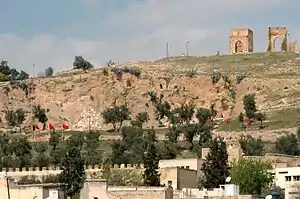
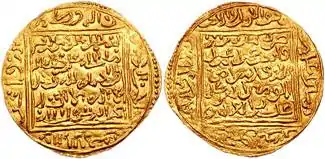

- 1215: The Banu Marin (Marinids) attacks the Almohads when the 16-year-old Almohad caliph Yusuf II Al-Mustansir comes to power in 1213. The battle takes place on the coast of the Rif. In the reign of Yusuf II Al-Mustansir a great tower is erected to protect the royal palace in Seville.[31]
- 1217: Abd al-Haqq I dies during victorious combat against the Almohads. His son Uthman ibn Abd al-Haqq (Uthman I) succeeds to the throne. Marinids take possession of the Rif and seem to want to remain there. The Almohades counterattack in vain.
- 1240: Uthman I is assassinated by one of his Christian slaves. His brother Muhammad ibn Abd Al-Haqq (Muhammad I) succeeds him.
- 1244: Muhammad I is killed by an officer of his own Christian mercenary militia. Abu Yahya ibn Abd al-Haqq, the third son of Abd Al-Haqq, succeeds him.
- 1249: Severe repression of anti-Marinid forces in Fes.
- 1258: Abu Yahya ibn Abd al-Haqq dies of disease. His uncle, Abu Yusuf Yaqub ibn Abd Al-Haqq, fourth son of Abd Al-Haqq, succeeds to the throne.
- 1260: The Castilians raid Salé.
- 1269: Seizure of Marrakesh and the end of Almohad domination of the western Maghreb.
- 1274: The Marinids seize Sijilmassa.
- 1276: Founding of Fes Jdid ("New Fes"), a new city near Fes, which comes to be considered a new district of Fes, in contrast to Fes el Bali ("Old Fes").
- 1286: Abu Yusuf Yaqub ibn Abd Al-Haqq dies of disease in Algeciras after a fourth expedition to the Iberian Peninsula. His son Abu Yaqub Yusuf an-Nasr replaces him.
- 1286: Abu Yaqub Yusuf an-Nasr combats revolts in and around the Draa River and the province of Marrakesh.
- 1288: Abu Yaqub Yusuf an-Nasr receives in Fes the envoys of the king of Granada, to whom the town of Cadiz is returned.
- 1291: Construction of the mosque of Taza, the earliest preserved Marinid building.
- 1296: Construction of Sidi Boumediene mosque, or Sidi Belhasan, in Tlemcen.
- 1299: Beginning of Tlemcen's siege by the Marinids, which will last nine years.
- 1306: Conquest and destruction of Taroudannt.
- 1307: Abu Yaqub Yusuf an-Nasr is assassinated by a eunuch in connection with some obscure matter related to the harem. His son Abu Thabit Amir succeeds to the throne.
- 1308: Abu Thabit dies of disease after only one year in power in Tetouan, a city which he has just founded. His brother, Abu al-Rabi Sulayman succeeds him.
- 1309: Abu al-Rabi Sulayman enters Ceuta.
- 1310: Abu al-Rabi dies of disease after having repressed a revolt of army officials in Taza. Among them is Gonzalve, chief of the Christian militia. His brother Abu Said Uthman succeeds him to the throne.
- 1323: Construction of the Attarin's madrasa in Fes.
- 1325: Ibn Battuta begins his 29-year journey across Africa and Eurasia.
- 1329: The Marinids defeat the Castilians in Algeciras, establishing a foothold in the south of the Iberian peninsula with the hope of reversing the Reconquista.
- 1331: Abu Said Uthman dies. His son Abu al-Hasan ibn Uthman succeeds him.
- 1337: First occupation of Tlemcen.
- 1340: A combined Portuguese–Castilian army defeats the Marinids in the Battle of Rio Salado, close to Tarifa, the southernmost town of the Iberian peninsula. The Marinids return to Africa.
- 1344: The Castilians take over Algeciras. The Marinids are definitively ejected from Iberia.
- 1347: Abu al-Hasan ibn Uthman destroys the Hafsid dynasty of Tunis and restores his authority over all the Maghreb.
- 1348: Abu al-Hasan dies, his son Abu Inan Faris succeeds him as Marinid ruler.
- 1348: The Black Death and the rebellions of Tlemcen and Tunis mark the beginning of the decline of the Marinids, who are unable to drive back the Portuguese and the Castilians.
- 1350: Construction of Bou Inania madrasa in Meknes.
- 1351: Second seizure of Tlemcen.
- 1357: Defeat of Abu Inan Faris in front of Tlemcen. Construction of another Bou Inania Madrasa in Fes.
- 1358 Abu Inan is assassinated by his vizir. A time of confusion starts. Each vizir tries to install weak candidates on the throne.
- 1358: Abu Zian as-Said Muhammad ibn Faris is named sultan by the vizirs, just after the assassination of Abu Inan. His reign lasts only a few months. Abu Yahya abu Bakr ibn Faris comes to power, but also reigns only a few months.
- 1359: Abu Salim Ibrahim is nominated sultan by the vizirs. He is one of the sons of Abu al-Hasan ibn Uthman and is supported by the king of Castille, Pedro.
- 1359: Resurgence of the Zianids of Tlemcen.
- 1361: Abu Umar Tachfin is named the successor to Abu Salim Ibrahim by the vizirs, with the support of the Christian militia. He reigns only a few months.
- 1361: The period called the "reign of the vizirs" ends.
- 1362: Muhammad ibn Yaqub assumes power. He is a young son of Abu al-Hasan ibn Uthman, who had taken refuge in Castile.
- 1366: Muhammad ibn Yaqub is assassinated by his vizir. He is replaced by Abu Faris Abd al-Aziz ibn Ali, one of the sons of Abu al-Hasan ibn Uthman who until this time had been held locked up in the palace of Fes.
- 1370: Third seizure of Tlemcen.
- 1372: Abu Faris Abd al-Aziz ibn Ali dies of disease leaving the throne to his very young son Muhammad as-Said, beginning a new period of instability. The vizirs try on several occasions to install a puppet sovereign.
- 1373: Muhammad as-Said is presented as the heir to his father, Abu Faris Abd al-Aziz ibn Ali, but being only five years old cannot reign, and dies in the same year.
- 1374: Abu al-Abbas Ahmad, supported by the Nasrid princes of Granada, takes power.
- 1374: Partition of the empire into two kingdoms: the Kingdom of Fes and the Kingdom of Marrakech.
- 1384: Abu al-Abbas is temporarily removed by the Nasrids. The Nasrids replace him with Abu Faris Musa ibn Faris, a disabled son of Abu Inan Faris. This ensures a kind of interim during the reign of Abu al-Abbas Ahmad from 1384 to 1386.
- 1384: Abu Zayd Abd ar-Rahman reigns over the Kingdom of Marrakech from 1384 to 1387 while the Marinid throne is still based in Fes.
- 1386: Al-Wathiq ensures the second part of the interim in the reign of Abu al-Abbas from 1386 to 1387.
- 1387: Abu Al-Abbas begins to give vizirs more power. Morocco knows six years of peace again, although Abu Al-Abbas benefits from this period to reconquer Tlemcen and Algiers.
- 1393: Abu Al-Abbas dies. Abu Faris Abd al-Aziz ibn Ahmad is designated as the new sultan. The troubles which follow the sudden death of Abu Al-Abbas in Taza make it possible for the Christian sovereigns to carry the war into Morocco.
- 1396: Abu Amir Abdallah succeeds to the throne.
- 1398: Abu Amir dies. His brother, Abu Said Uthman ibn Ahmad, takes power.
- 1399: Benefitting from the anarchy within the Marinid kingdom, king Henry III of Castile arrives in Morocco, seizes Tetouan, massacres half of the population and reduces the rest to slavery.
- 1415: King John I of Portugal seizes Ceuta. This conquest marks the beginning of overseas European expansion.
- 1418: Abu Said Uthman besieges Ceuta but is defeated.
- 1420: Abu Said Uthman dies. He is replaced by his son, Abu Muhammad Abd al-Haqq, who is only one year old.
- 1437: Failure of a Portuguese expedition to Tangier. Many prisoners are taken and the infant Fernando, the Saint Prince is kept as a hostage. A treaty is made with the Portuguese enabling them to embark if they return Ceuta. Fernando is kept as a hostage to guarantee the execution of this pact. Influenced by Pope Eugene IV, Edward of Portugal sacrifices his brother for national trade interests.
- 1458: King Afonso V of Portugal prepares an army for a crusade against the Ottomans in response to the call of Pope Pius II, but he instead uses the army to attack a small port located between Tangier and Ceuta.
- 1459: Abu Muhammad Abd Al-Haqq revolts against his own Wattasid vizirs. Only two brothers survive, who will become the first Wattasid sultans in 1472.
- 1462: Ferdinand IV of Castile takes over Gibraltar.
- 1465: Abu Muhammad Abd Al-Haqq appoints a Jewish vizir, Aaron ben Batash, provoking a popular revolt. The sultan dies in the revolt when his throat is cut. The Portuguese king Afonso V finally manages to take Tangier, benefitting from the troubles in Fes.
- 1472: Abu Abd Allah al-Sheikh Muhammad ibn Yahya, one of the two Wattasid vizirs surviving the 1459 massacre, installs himself in Fes, where he founds the Wattasid dynasty.
Culture

.jpg.webp)
Intellectual life and education
The Marinids were eager patrons of Islamic scholarship and intellectual culture. It was in this period that the Qarawiyyin, the main center of learning in Fes, reached its apogee in terms of prestige, patronage, and intellectual scope.[32][33][34]:141 Additionally, the Marinids were prolific builders of madrasas, a type of institution which originated in northeastern Iran by the early 11th century and was progressively adopted further west.[35] These establishments served to train Islamic scholars, particularly in Islamic law and jurisprudence (fiqh). The madrasa in the Sunni world was generally antithetical to more "heterodox" religious doctrines, including the doctrine espoused by the preceding Almohads. As such, it only came to flourish in Morocco under the Marinids that followed them.[35] To the Marinids, madrasas played a part in bolstering the political legitimacy of their dynasty. They used this patronage to encourage the loyalty of Fes's influential but fiercely independent religious elites and also to portray themselves to the general population as protectors and promoters of orthodox Sunni Islam.[35][36] The madrasas also served to train the scholars and elites who operated their state's bureaucracy.[36]
Many of these madrasas were built near the major mosques which had already acted as older centers of learning, such as the Qarawiyyin, the Mosque of the Andalusians, and the Grand Mosque of Meknes. One of their most important functions seems to have been to provide housing for students from other towns and cities – many of them poor – who needed a place to stay while studying at these major centers of learning.[37]:137[33]:110[38]:463 In Fes, the first madrasa was the Saffarin Madrasa built in 1271, followed by the Sahrij Madrasa founded in 1321 (and the Sba'iyyin Madrasa next to it two years later), the al-Attarine in 1323, and the Mesbahiya Madrasa in 1346.[39] Another madrasa, built in 1320 near the Grand Mosque of Fes el-Jdid, was less successful in contributing to the city's scholarly life.[38][33]:114 These madrasas taught their own courses and sometimes became well-known institutions in their own right, but they usually had much narrower curriculums or specializations than the Qarawiyyin.[33]:141[40] The last and largest Marinid madrasa in Fes, the Bou Inania, was a slightly more distinctive institution and was the only madrasa to also have the status of a Friday mosque.[35][36] Marinid madrasas built in other cities include the Madrasa of Abu al-Hasan in Salé and the Bou Inana Madrasa of Meknes.[41]
Architecture
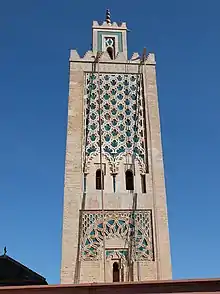
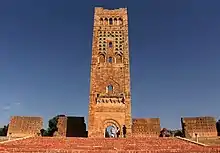
The Marinid dynasty was important in further refining the artistic legacy established under their Almoravid and Almohad predecessors. Particularly in Fes, their capital, they built monuments with increasingly intricate and extensive decoration, particularly in wood and stucco.[35] They were also the first to deploy extensive use of zellij (mosaic tilework in complex geometric patterns), which became standard in Moroccan architecture afterwards.[42] Their architectural style was very closely related to that found in the Emirate of Granada, in Spain, under the contemporary Nasrid dynasty.[35] The decoration of the famous Alhambra is thus reminiscent of what was built in Fes at the same time. When Granada was conquered in 1492 by Catholic Spain and the last Muslim realm of al-Andalus came to an end, many of the remaining Spanish Muslims (and Jews) fled to Morocco and North Africa, further increasing the Andalusian cultural influence in these regions in subsequent generations.[41]
Notably, the Marinids were the first to build madrasas in the region.[35] The madrasas of Fes, such as the Bou Inania, al-Attarine, and Sahrij madrasas, as well as the Marinid madrasa of Salé and the other Bou Inania in Meknes, are considered among the greatest architectural works in western Islamic architecture of this period.[43][41][35] While mosque architecture largely followed the Almohad model, one noted change was the progressive increase in the size of the sahn or courtyard, which was previously a minor element of the floor plan but which eventually, in the subsequent Saadian period, became as large as the main prayer hall and sometimes larger.[44] Notable examples of Marinid mosque architecture are the Grand Mosque of Fes el-Jdid (founded in 1276, one of the earliest Marinid mosques), the expansion of the Great Mosque of Taza in 1294, the Mosque of al-Mansourah near Tlemcen (1303), and the Mosque of Sidi Abu Madyan (1338-39).[45] The Ben Salah Mosque in Marrakesh also dates from the Marinid period, one of the few monuments from this period in the city.
Of the Marinid royal palaces in Fes el-Jdid little has survived, with the current Royal Palace of Fes dating mainly from the later Alaouite period. Likewise, the former Marinid Royal Gardens to the north have disappeared and the Marinid Tombs on the hills overlooking Fes el-Bali are largely ruined.[46] Some Marinid monumental gates, such as the gate of the Chellah necropolis near Rabat and the Bab el-Mrissa in Salé, are still standing today and demonstrate resemblances with earlier Almohad models.[35]
List of Marinid rulers
The following is the sequence of Marinid rulers from the founding of the dynasty to its end.[47][4]
1215–1269 : leaders of the Marinids, engaged in a struggle against the Almohads, based in Taza from 1216 to 1244
- Abd al-Haqq I (1215–1217)
- Abu Sa'id Uthman I (1217–1240)
- Abu Ma'ruf Muhammad I (1240–1244)
Since 1244 : Marinid Emirs based in Fez
- Abu Yahya ibn Abd al-Haqq (1244–1258)
- Abu Yusuf Yaqub (1258–1269)
1269–1465 : Marinid Sultans of Fez and Morocco
- Abu Yusuf Yaqub (1269–1286)
- Abu Yaqub Yusuf al-Nasir (1286–1307)
- Abu Thabit 'Amir (1307–1308)
- Abu al-Rabi Sulayman (1308–1310)
- Abu Sa'id Uthman II (1310–1331)
- Abu al-Hasan 'Ali (1331–1351)
- Abu Inan Faris al-Mutawakkil (1348–1358)
- Abu Zayyan Muhammad II (1358; first reign)
- Abu Yahya Abu Bakr ibn Faris (1358–1359)
- Abu Salim Ibrahim ibn 'Ali (1359–1361)
- Abu 'Amr Tashfin ibn 'Ali (1361)
- Abu Zayyan Muhammad II (1361–1365; second reign)
- Abu Faris Abd al-Aziz I al-Mustansir (1365–1372)
- Abu Zayyan Muhammad III (1372–1374)
- Abu 'l-Abbas Ahmad I al-Mustansir (1373–1384, 1387–1393)
- Abu Faris Musa ibn Faris (1384–1386)
- Abu Zayyan Muhammad IV ibn Ahmad I (1386)
- Abu Zayyan Muhammad V ibn Ali (1386–1387)
- Abu 'l-Abbas Ahmad II ibn Ahmad I (1387–1393)
- Abu Faris Abd al-Aziz II ibn Ahmad II (1393–1396)
- Abu 'Amir Abdallah ibn Ahmad II (1396–1397)
- Abu Sa'id Uthman III (1398–1420)
- Abu Muhammad Abd al-Haqq II (1420–1465)
See also
- Marinid Tombs in Fes
- List of Sunni Muslim dynasties
References
- "Marinid dynasty (Berber dynasty) - Encyclopædia Britannica". Britannica.com. Retrieved 24 February 2014.
- "Marinides ou Mérinides ; Dynastie marocaine (1269-1465) - Encyclopédie Larousse en ligne". Larousse.fr. Retrieved 5 June 2016.
- Abun-Nasr, Jamil (1987). A history of the Maghrib in the Islamic period. Cambridge: Cambridge University Press. pp. 103–118. ISBN 0521337674.
- C.E. Bosworth, The New Islamic Dynasties, (Columbia University Press, 1996), 41-42.
- Universalis, Encyclopædia. "MÉRINIDES LES". Encyclopædia Universalis.
- Niane, D.T. (1981). General History of Africa. IV. p. 91. ISBN 9789231017100. Retrieved 24 February 2014.
- Bosworth, Clifford Edmund (2004). The New Islamic Dynasties: A Chronological and Genealogical Manual. Edinburgh University Press. ISBN 9780748621378.
- Ira M. Lapidus, Islamic Societies to the Nineteenth Century: A Global History, (Cambridge University Press, 2012), 414.
- Le Tourneau, Roger (1949). Fès avant le protectorat: étude économique et sociale d'une ville de l'occident musulman. Casablanca: Société Marocaine de Librairie et d'Édition.
- Lintz, Yannick; Déléry, Claire; Tuil Leonetti, Bulle (2014). Le Maroc médiéval: Un empire de l'Afrique à l'Espagne. Paris: Louvre éditions. pp. 432–435. ISBN 9782350314907.
- Roger Le Tourneau (8 December 2015). Almohad Movement in North Africa in the 12th and 13th Centuries. Princeton University Press. pp. 490–491. ISBN 978-1-4008-7669-3.
- Ahmed Khaneboubi (2008). Les institutions gouvernementales sous les Mérinides: 1258-1465. L'Harmattan. ISBN 978-2-296-06644-1.
- Shatzmiller, M. (1991). "Marīnids". In Bearman, P.; Bianquis, Th.; Bosworth, C.E.; van Donzel, E.; Heinrichs, W.P. (eds.). Encyclopaedia of Islam. VI (2nd ed.). Leiden, Netherlands: E. J. BRILL. p. 571. ISBN 9004081127.
- Powers, David S. (2002). Law, Society and Culture in the Maghrib, 1300-1500. Cambridge University Press. p. 101. ISBN 978-0-521-81691-5.
- Torremocha Silva, Antonio (2006). "The Nasrids of Granada and the Marinids of the Maghrib". In Viguera, Maria Jesús (ed.). Ibn Khaldun: The Mediterranean in the 14th Century : Rise and Fall of Empires. Fundación El legado andalusì. p. 78. ISBN 978-84-96556-34-8.
- Fromherz, Allen James (2011). Ibn Khaldun. Edinburgh University Press. p. 16. ISBN 978-0-7486-5418-5.
- Abun-Nasr, Jamil M. (1987). A History of the Maghrib in the Islamic Period. Cambridge University Press. p. 103. ISBN 978-0-521-33767-0.
- Idris El Hareir (2011). The Spread of Islam Throughout the World. UNESCO. p. 420. ISBN 9789231041532.
- "Encyclopédie Larousse en ligne - Marinides ou Mérinides". Larousse.fr. Retrieved 24 February 2014.
- C.E. Bosworth, The New Islamic Dynasties, 42.
- The Report: Morocco 2009 - Oxford Business Group - Google Boeken. ISBN 9781907065071. Retrieved 24 February 2014.
- "An Architectural Investigation of Marrind and Wattasid Fes Medina (674-961/1276-1554), In Terms of Gender, Legend, and Law" (PDF). Etheses.whiterose.ac.uk. Retrieved 24 February 2014.
- "An architectural Investigation of Marinid and Watasid Fes" (PDF). Etheses.whiterose.ac.uk. p. 23. Retrieved 24 February 2014.
- E.J. Brill's First Encyclopaedia of Islam 1913-1936 - Google Boeken. 1987. ISBN 9004082654. Retrieved 24 February 2014.
- Shatzmiller, Maya (2000). The Berbers and the Islamic State - Maya Shatzmiller - Google Boeken. ISBN 9781558762244. Retrieved 24 February 2014.
- Fairchild Ruggles, D. (25 April 2011). Islamic Art and Visual Culture: An Anthology of Sources - Google Boeken. ISBN 9781405154017. Retrieved 24 February 2014.
- "Al- Hakawati". Al-hakawati.net. Archived from the original on 25 June 2013. Retrieved 24 February 2014.
- Bosworth, Clifford Edmund (January 1989). The Encyclopedia of Islam, Volume 6, Fascicules 107-108 - Clifford Edmund Bosworth - Google Boeken. ISBN 9004090827. Retrieved 24 February 2014.
- Julien, Charles-André, Histoire de l'Afrique du Nord, des origines à 1830, Payot 1931, p.196
- C.E. Bosworth, The New Islamic dynasties, p.42 Edinburgh University Press 1996. ISBN 978-0-231-10714-3.
- E.J. Brill's first encyclopaedia of Islam, M. Th Houtsma
- Lulat, Y. G.-M.: A History Of African Higher Education From Antiquity To The Present: A Critical Synthesis, Greenwood Publishing Group, 2005, ISBN 978-0-313-32061-3, pp. 154–157
- Gaudio, Attilio (1982). Fès: Joyau de la civilisation islamique. Paris: Les Presse de l'UNESCO: Nouvelles Éditions Latines. ISBN 2723301591.
- Deverdun, Gaston (2012). "al-Ḳarawiyyīn". Encyclopaedia of Islam, Second Edition. Brill.
- Marçais, Georges (1954). L'architecture musulmane d'Occident. Paris: Arts et métiers graphiques.
- Lintz, Yannick; Déléry, Claire; Tuil Leonetti, Bulle (2014). Maroc médiéval: Un empire de l'Afrique à l'Espagne. Paris: Louvre éditions. ISBN 9782350314907.
- Parker, Richard B. (1981). A practical guide to Islamic Monuments in Morocco. Charlottesville, VA: The Baraka Press.
- Le Tourneau, Roger (1949). Fès avant le protectorat: étude économique et sociale d'une ville de l'occident musulman. Casablanca: Société Marocaine de Librairie et d'Édition.
- Kubisch, Natascha (2011). "Maghreb - Architecture". In Hattstein, Markus; Delius, Peter (eds.). Islam: Art and Architecture. h.f.ullmann. pp. 312–313.
- Irwin, Robert (2019). Ibn Khaldun: An Intellectual Biography. Princeton University Press. p. 29.
- Touri, Abdelaziz; Benaboud, Mhammad; Boujibar El-Khatib, Naïma; Lakhdar, Kamal; Mezzine, Mohamed (2010). Le Maroc andalou : à la découverte d'un art de vivre (2 ed.). Ministère des Affaires Culturelles du Royaume du Maroc & Museum With No Frontiers. ISBN 978-3902782311.
- Parker, Richard (1981). A practical guide to Islamic Monuments in Morocco. Charlottesville, VA: The Baraka Press.
- Kubisch, Natascha (2011). "Maghreb - Architecture" in Hattstein, Markus and Delius, Peter (eds.) Islam: Art and Architecture. h.f.ullmann.
- Salmon, Xavier (2016). Marrakech: Splendeurs saadiennes: 1550-1650. Paris: LienArt. ISBN 9782359061826.
- Bloom, Jonathan M. (2020). Architecture of the Islamic West: North Africa and the Iberian Peninsula, 700-1800. Yale University Press.
- Bressolette, Henri (2016). A la découverte de Fès. L'Harmattan. ISBN 978-2343090221.
- Shatzmiller, M. (1991). "Marīnids". In Bearman, P.; Bianquis, Th.; Bosworth, C.E.; van Donzel, E.; Heinrichs, W.P. (eds.). Encyclopaedia of Islam. VI (2nd ed.). Leiden, Netherlands: E. J. BRILL. p. 573. ISBN 9004081127.
Bibliography
- JULIEN, Charles-André, Histoire de l'Afrique du Nord, des origines à 1830, édition originale 1931, réédition Payot, Paris, 1994 (in French)
- Marinid Dynasty at Encyclopædia Britannica
| Wikimedia Commons has media related to Marinid dynasty. |
— Royal house — Banu Marin | ||
| Preceded by Almohad dynasty |
Ruling house of Morocco 1269–1465 |
Succeeded by Idrisid dynasty Joutey branch |
.svg.png.webp)
.jpg.webp)
